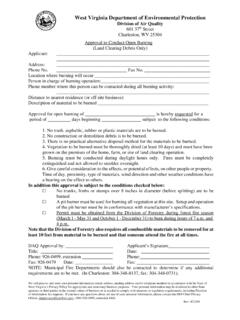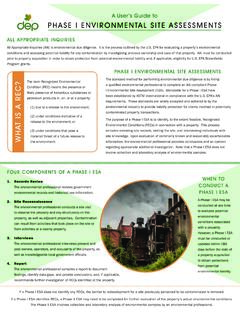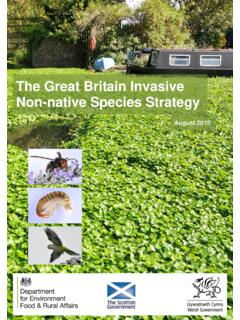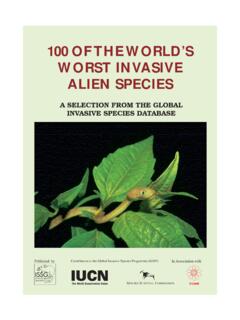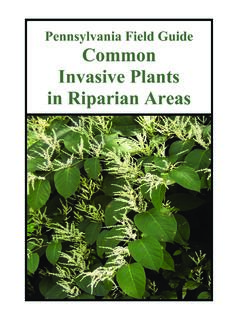Transcription of FIELD GUIDE TO Common Wetland Plants
1 FIELD GUIDE TOCommon Wetland Plants OF WEST VIRGINIAThis FIELD GUIDE was prepared by the West Virginia Department of Environmental Protection (WVDEP), Watershed Assessment Branch (WAB). WAB provides state leadership to collect and analyze data to determine the quality of waterbodies in West Virginia in relation to the Clean Water project has been funded in part by the Environmental Protection Agency s Wetland Program Development Grant # contents of this document do not necessarily reflect the views and policies of the West Virginia Department of Environmental Protection nor of the Environmental Protection GUIDE TO THE Common Wetland Plants OF WEST VIRGINIA iField Guideto Common Wetland Plants of West VirginiaBy Patricia L. Faulkner & Elizabeth A. ByersWatershed Assessment BranchDivision of Water and Waste ManagementWest Virginia Department of Environmental Protection601 57th Street Charleston, WV 25304 (304) 926-0495 WEST VIRGINIA DEPARTMENT OF ENVIRONMENTAL PROTECTIONA cknowledgements SPECIAL THANKS to Donna Ford-Werntz, Jim Vanderhorst, Brian Streets, Sarah Chamberlain, Danielle Elliott, and Jason Ely for reviewing the GUIDE and providing helpful credited here kindly allowed use of their works for the non-commercial educational purposes of this document.
2 We express sincere appreciation for the many naturalists who shared their images of Wetland Plants through Creative Commons licenses, and who are credited on individual photographs. In addition, the following photographers and organizations generously provided multiple botanically detailed images: Anna Anisko illustrations reprinted with permission of the University of Pennsylvania Press from The Plants of Pennsylvania pp 129, 130, & 198, Bruce Ackley, Larry Allain Geological Survey, Albert Bussewitz, Elizabeth Byers, Donald Cameron, Katy Chayka, Dawn Dentzer, Peter M. Dziuk, Patricia Faulkner LA Dept. of Wildlife & Fisheries, Arthur Haines, iNaturalist, Marilee Lovit, The Minnesota Wildflowers Information Organization, Glen Mittelhauser, Native Plant Trust, New York State Museum, Bruce Patterson, Rob Routledge, Rosanna Springston, Brian Streets, Donald Sutherland, Jim Vanderhorst. Use of graphics for the Plant ID tips kindly allowed by the Delaware Department of Natural Resources and Environmental Control.
3 Cover photos by Jim Vanderhorst (Carex lupulina), Brian Streets (Sagittaria latifolia), and Elizabeth Byers (Cephalanthus occidentalis, Ilex verticillata).SINCERE THANKS to artist Rachel Gaziano for her illustrations of the growth habit CITATIONF aulkner, P. L. and E. A. Byers. 2019. FIELD GUIDE to the Common Wetland Plants of West Virginia. West Virginia Department of Environmental Protection. Charleston, GUIDE TO THE Common Wetland Plants OF WEST VIRGINIA iiiTable of contentsINTRODUCTION1 EVERGREEN TREES8 BROADLEAF TREES11 SHRUBS27 VINES43AQ UATI C S46 FORBS51 GRAMINOIDS73 FERNS103 MOSSES107 REFERENCES108 INDEX109 FIELD GUIDE TO THE Common Wetland Plants OF WEST VIRGINIA 1 What is a Wetland ?Wetlands are areas where the land is covered by shallow water or the soil is saturated to or near the surface for at least two weeks during the growing season. Wetlands are wet enough to affect the types of soils and Plants that can occur, but they may also be dry at certain times of the year.
4 Plants and many animals found in wetlands are specially adapted to live in these wet conditions. Wetlands can be found in every county of West Virginia. Some Common names for different types of wetlands are swamp, marsh, and have three characteristics:1. Water at or near the soil surface for some part of the year,2. Hydrophytic ( Wetland ) Plants , which are plant species adapted to living in wet soil conditions,3. Hydric soils, which are soils that are permanently or seasonally flooded or saturated, resulting in oxygen loss from soil pores (anaerobic conditions).This GUIDE introduces the 100 most Common Wetland Plants in the state and provides tips on how to distinguish them from similar WEST VIRGINIA DEPARTMENT OF ENVIRONMENTAL PROTECTIONHow this GUIDE is organizedEVERGREEN TREEW oody plant more than 6 meters tall when mature and typically with a single trunk. Leaves are needle-like and remain green through the TREEW oody plant more than 6 meters tall when mature and typically with a single trunk.
5 Leaves are broad and shed in plant less than 6 meters tall when mature and typically with multiple woody plant with a climbing or trailing UATI CFlowering plant that is typically submerged in water or floating on plant with broad leaves and without woody flowering plant including grasses, sedges and vascular plant that reproduces by non-vascular plant that lacks true roots, is low growing, and reproduces by GROUPSThe Common Plants in this guidebook are organized into nine plant groups denoted by colored bars and growth habit icons at the top of each plant GUIDE TO THE Common Wetland Plants OF WEST VIRGINIA 3 PLANT NAMES AND FAMILIESL isted at the top of each plant page are both the scientific and Common names, as well as the plant family to which that plant belongs. Nomenclature follows the USDA Plants list ( ).PLANT ORIGINSNATIV E: A plant that is a part of the balance of nature that has developed over hundreds or thousands of years in a particular region or ecosystem.
6 Only Plants found in West Virginia prior to European settlement are considered to be O N - NATIV E: A plant introduced with human help (intentionally or accidentally) to a new place or new type of habitat where it was not previously : A plant that is able to establish on many sites, grow quickly, and spread to the point of disrupting plant communities or nameCommon nameSAMPLE PAGEP lant familyPlant originWetland Indicator Status (WIS)Coefficient of Conservation (CoC)Description of plantDescription of flowers and fruitsHabitatDescription of similar speciesPlant group4 WEST VIRGINIA DEPARTMENT OF ENVIRONMENTAL PROTECTIONWETLAND INDICATOR STATUS (WIS)The following are standard ranking designations indicating a plant species likelihood of occurring in a CODEDEFINITION% OCCURRENCEOBLO bligate: Almost always occurs in wetlands under natural conditions in our region99 FAC WFacultative Wetland : Usually occurs in wetlands but occasionally found in non-wetlands67-98 FACF acultative: Equally likely to occur in wetlands and non-wetlands34-66 FACUF acultative Upland: Usually occurs in non-wetlands, but occasionally found in wetlands33 -1 UPLU pland: Almost always occurs in non-wetlands under natural conditions in our region<1 FIELD GUIDE TO THE Common Wetland Plants OF WEST VIRGINIA 5 COEFFICIENT OF CONS E RVATI SM (CO C)This is a numerical value assigned to plant species indicating their invasiveness, their likelihood of occurring in a particular habitat, and their tolerance and response to habitat disturbances.
7 The Coefficient of Conservatism is the basic variable used in Floristic Quality Assessment (FQA). The principal concept of the FQA is that the quality of a natural plant community can be objectively evaluated by the degree of plant species conservatism to the natural community. Values used for Wetland assessment in West Virginia are listed aggressive invasive Plants -3 Moderately invasive Plants -1 Occasionally invasive plants0 Non-native non- invasive plants1-2 Native Plants with a wide range of ecological tolerances and adapted to severe habitat degradation. These weedy species thrive under conditions of anthropogenic disturbance. 3-4 Native Plants associated with more stable though degraded habitat, but which may be found in a variety of habitats. They are generally widespread and not an indicator of a particular community Plants with an intermediate range of ecological tolerances and often associated with a specific natural vegetation community. They include many Common dominant species that can persist under moderate Plants with a narrow range of ecological tolerances, often associated with advanced successional stage, and typically associated with stable natural vegetation communities and natural areas.
8 They can persist where habitat has been slightly -10 Native Plants with a very high degree of fidelity to a narrow range of pristine habitats, and highly sensitive to anthropogenic disturbance. They are generally restricted to high-quality natural WEST VIRGINIA DEPARTMENT OF ENVIRONMENTAL PROTECTIONP lant identification involves carefully observing patterns in the many characteristics that define each plant species. This book is a beginning tool to help you identify the most Common Wetland Plants in West Virginia, and so we have used non-technical descriptions as much as possible. The focal characteristics include size, habit or shape, stem and branch structure, leaf composition and arrangement, textures, colors, flowers and fruits. The flowering and fruiting times and typical habitat are useful clues. Often there are species that look similar and may be growing in the same habitat. Always double check all the characteristics. Included is a section on each plant page to help you avoid mistaking these similar OF A LEAFVein: vascular tissue circulating water & nutrientsSinus: space between two lobes or teethMidrib: the central veinLeaf margins: outer edgesAxil: where leaf meets stemNode: where leaves emergePetiole: leaf stalkEntirePlant identification tipsENTIRE, TOOTHED, OR LOBED MARGINS?
9 To oth e dLobedFIELD GUIDE TO THE Common Wetland Plants OF WEST VIRGINIA 7 LEAF STRUCTURES implePinnately compoundPalmately compoundLEAF ARRANGEMENTA lternateOppositeWhorledPARTS OF A FLOWERF lowers have different parts that can be used to help identify a particular or Pistil (female)Stamen (male)8 WEST VIRGINIA DEPARTMENT OF ENVIRONMENTAL PROTECTIONP icea rubensred spruceFamilyPinaceaeOriginNativeWIS CodeFACCoC8 DESCRIPTIONE vergreen tree (to 35 m tall) with a narrow cone-shaped crown, whorled branches, and reddish rough bark with irregular thin brown scales. Twigs and buds are orange-brown, with fine hairs along twigs, and lower branches spreading downward. Needles (leaves) (12 to 15 mm) are yellow-green to dark-green, 4-sided so that they roll easily between the finger and thumb, sharply pointed, and arise from a peg-like base (sterigma). The sterigma persists after needles fall, giving the denuded branches a rough AND SEED CONESMay to June; October to November.
10 Male cones are cylindrical, reddish turning yellow-brown when pollen is released. Young seed cones are purplish developing into woody cones (3 to cm long) with smooth-edged, fan-shaped scales (widest near the tip), enclosing the developing swamps, bogs, and forests at high SPECIESP icea abies, Norway spruce, is a non-native with larger cones 12 to 16 cm long (versus only 3 to cm for P. rubens). Most branches droop conspicuously in mature trees. Young Picea trees are difficult to tell apart, but Picea abies twigs typically have few hairs, and the individual needles are flatter so they don t roll easily between the finger and rubens seed cones Matt Muir Arthur Haines Erika Mitchell Owen ClarkinPicea abies seed cones Fred LosiFIELD GUIDE TO THE Common Wetland Plants OF WEST VIRGINIA 9 Pinus rigidapitch pineFamilyPinaceaeOriginNativeWIS CodeFACCoC5 DESCRIPTIONE vergreen tree (to 30 m tall) with dark to yellowish-brown platy rough bark. Needles (leaves) are 4 to 15 cm long, dark green to yellow-green, stiff, both twisted and straight with three per fascicle (bundle of needles wrapped at base by papery sheath).

